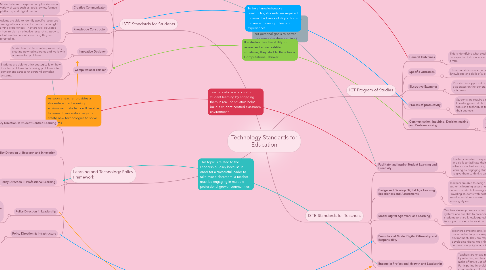
1. ISTE Standards for Students
1.1. Empowered Learner
1.1.1. Students articulate and set person learning goals to develop strategies to better understand technology itself. They are motivated to learn about the fundamental concepts of technology operations where they will apply to their knowledge to explore ever evolving technologies.
1.2. Creative Communicator
1.2.1. Students learn to express complex ideas in a variety of ways such as: tools, styles, formats, platforms, and digital media.
1.3. Knowledge Constructor
1.3.1. Students are able to identify specific resources from digital tools needed to create meaningful learning experiences. They are well educated on how to plan an effective research strategy to find information about something they are interested in.
1.4. Innovative Designer
1.4.1. Students are able to solve problems by creating new technologies and work with open-ended problems.
1.5. Computational Thinker
1.5.1. Students are able to think strategically on how to solve problems by breaking problems into component parts to understand complex systems.
2. Learning and Technology Policy Framework
2.1. Policy Direction 1: Student-Centred Learning
2.1.1. In order for a classroom have student-centred learning, the actions that should occur is establishing a vision for technology, and providing guidance and support for those who do not know how to use digital tools. To make learning more about what they want and need and integrating useful technology tools to further build their innovative minds.
2.2. Policy Direction 2: Research and Innovation
2.2.1. The Ministry of Education will host online provincial resources for educational purposes. They will support world wide exchanges and collaborations related to their educational purposes.
2.3. Policy Direction 3: Professional Learning
2.3.1. To gain confidence teachers, we must encourage teachers to engage in professional growth opportunities. To diversify themselves in other cities or countries to further expand their knowledge of technology from other teachers. Building a professional network will be beneficial for teachers who need extra resources for their classrooms.
2.4. Policy Direction 4: Leadership
2.4.1. To be a education leader, a teacher must be able to use technology innovatively, effectively, and efficiently. This will help maintain the leverage of technology in a student-centred learning environment.
2.5. Policy Direction 5: Infrastructure
2.5.1. Ministry of Education ensures that they support access to safe and secure system that will allow students to explore through different websites with reliable knowledge.
3. ISTE Standards for Teachers
3.1. Facilitate and Inspire Student Learning and Creativity
3.1.1. Teachers are able to expand their knowledge and skills to facilitate their experiences to advance student learning. Promoting student learning by engaging students in real-life issues to give them to think creatively.
3.2. Design and Develop Digital Age Learning Experiences and Assessments
3.2.1. Teachers are able to design and develop authentic learning assessments to further enhance students learning in context. Providing students with customize learning activities to cater to all students learning styles.
3.3. Model Digital Age Work and Learning
3.3.1. Teachers develop fluency in technology systems and are able to collaborate with students to share knowledge using digital tools to support students innovation.
3.4. Promote and Model Digital Citizenship and Responsibility
3.4.1. Teachers advocate safe, legal, and ethical use of technology in a respectful environment. They are responsible for developing digital tools that cater to other cultures using digital age technology.
3.5. Engage in Professional Growth and Leadership
3.5.1. Teachers are engaging in professional growth by reflecting on their self use of digital tools to make effective use of emerging digital tools. Participating in evolving technology communities to further improve students learning.
4. ICT Program of Studies
4.1. General Outcomes
4.1.1. This is identifying what students should already be expected to know about different situations given.
4.2. Specific Outcomes
4.2.1. These are statements that identify the students knowledge and skills of a general outcome.
4.3. Illustrative Examples
4.3.1. Provided in supported document that elaborates on the general and specific outcomes.
4.4. Process of productivity
4.4.1. Students are required to know the basic knowledge and skills to use a variety of digital tools and techniques to further elaborate on their subjects.
4.5. Communication, Inquiring, Decision making and Problem solving
4.5.1. It is about the ability to assess information, manage inquiry, and solve problems to real-life situations.
